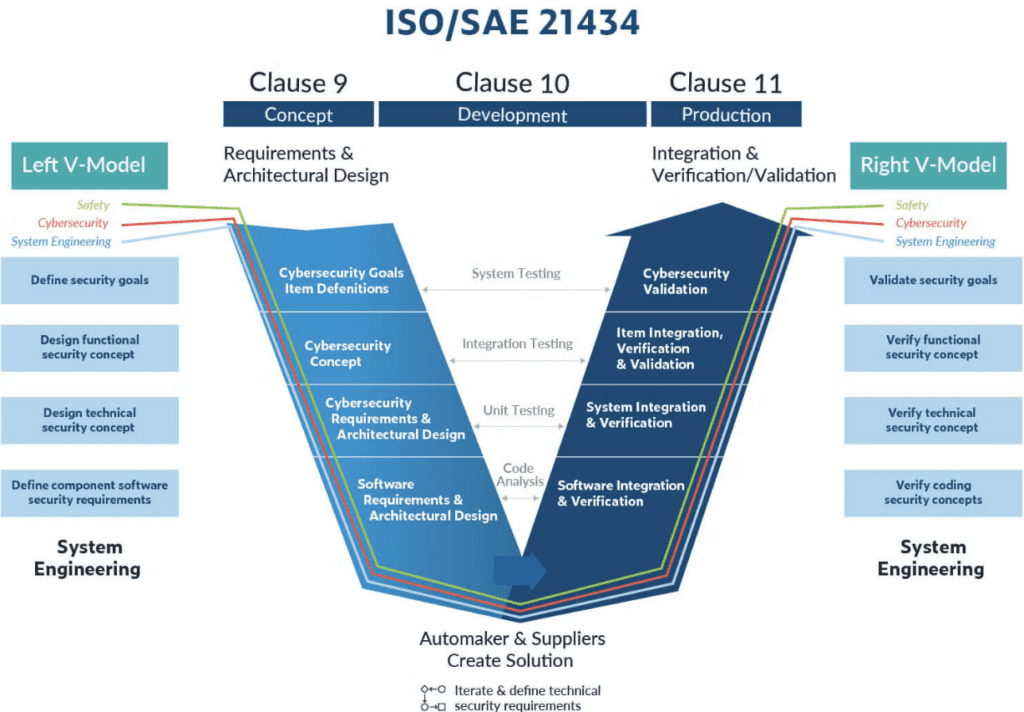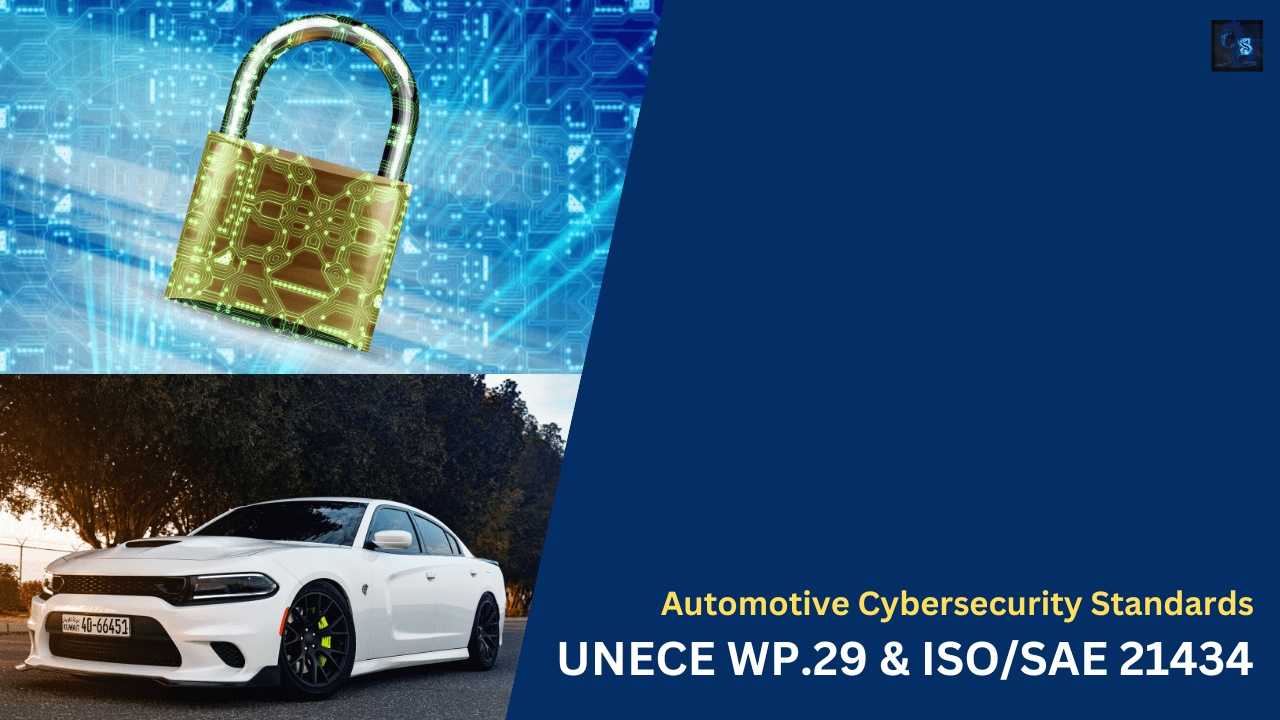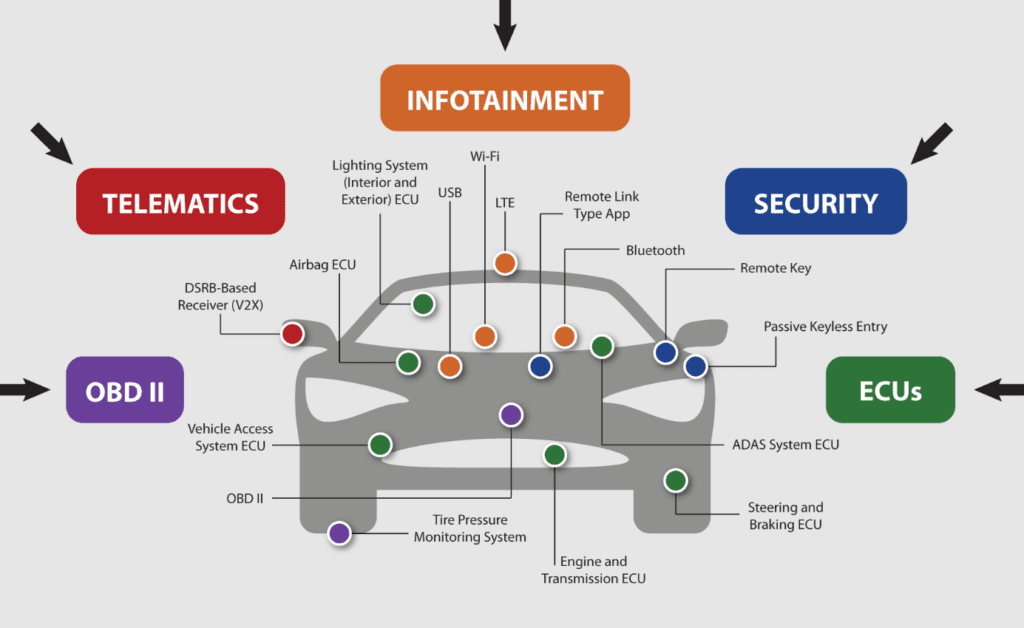Automotive Cybersecurity Standards: UNECE WP.29 & ISO/SAE 21434
Hello guys, welcome back to our blog. Here in this article, we will discuss Automotive Cybersecurity Standards, the need for automotive cybersecurity, and future trends.
Ask questions if you have any electrical, electronics, or computer science doubts. You can also catch me on Instagram – CS Electrical & Electronics
- Battery Swapping Vs Fast Charging: Which Is The Future Of EVs
- Future Of Solid-State Batteries In Electric Vehicles
- Convergence Of VLSI and Automotive Technologies: Driving Innovation In Modern Vehicles
Automotive Cybersecurity Standards
Modern cars are no longer just machines that move us from one place to another. Today’s vehicles are full of computers, sensors, and software that help control everything from the engine to the brakes and even provide entertainment and navigation. With all this technology comes the risk that someone could try to hack into a car’s system. Cybersecurity in the automotive world is all about protecting these systems from attacks that could lead to dangerous situations or privacy issues.
To address these risks, experts and regulators have created rules and guidelines to help car manufacturers build safer, more secure vehicles. Two of the most important sets of rules are UNECE WP.29 and ISO/SAE 21434. In this article, we explain these standards in a simple way.
Why Automotive Cybersecurity Is Important
Imagine if someone hacked into your car and took control of the steering wheel or brakes. That scenario might sound like a scene from a movie, but as cars become more connected, the risk grows. Here are some key reasons why automotive cybersecurity is so important:
- Safety: Hackers could interfere with a car’s systems, potentially causing accidents.
- Privacy: Modern vehicles collect data about where you drive, how you drive, and sometimes even personal information. If this data isn’t protected, it could be misused.
- Reliability: A secure car system means fewer breakdowns or glitches that might come from cyber attacks.
- Trust: Drivers need to trust that the cars they drive are safe from cyber threats. When manufacturers show they care about cybersecurity, it builds confidence among customers.
Because of these reasons, automotive cybersecurity has become a top priority for the entire industry.
What Is UNECE WP.29?

Background of UNECE WP.29
The United Nations Economic Commission for Europe (UNECE) is an organization that creates guidelines and rules for many industries, including automotive. UNECE’s World Forum for Harmonization of Vehicle Regulations, known as WP.29, has a long history of working on safety and environmental rules for vehicles. Recently, WP.29 has also taken up the challenge of making sure cars are safe from cyber-attacks.
Key Points of UNECE WP.29 Cybersecurity Rules
UNECE WP.29 sets out rules that car manufacturers must follow if they want to sell their vehicles in regions that accept these regulations. Here are the main points explained in simple language:
Cybersecurity Management System (CSMS): Manufacturers must have a system in place to manage all aspects of cybersecurity. This means they need to have processes to identify risks, protect the car systems, and fix any problems that come up.
Risk Assessment and Mitigation: Before a car is built, manufacturers must look at what kinds of cyber threats might affect it. They need to figure out the most important risks and put measures in place to reduce them. This process should start at the design stage and continue throughout the life of the vehicle.
Supply Chain Security: Modern cars are built using parts and software from many different suppliers. WP.29 requires manufacturers to make sure that every part of the supply chain follows good cybersecurity practices. This helps prevent weak links that could be exploited by hackers.
Incident Response: If a cybersecurity problem occurs, manufacturers must have a plan to respond quickly. This plan should include how to fix the issue and how to inform the relevant authorities and customers about the problem.
Certification and Compliance: Vehicles must be checked to ensure they meet these cybersecurity requirements before they are sold. In some cases, this might mean that a car is certified by an independent body or passes certain tests to prove it is secure.
What Does WP.29 Mean for Car Manufacturers?
For car companies, following WP.29 rules is not just about following the law—it’s also about protecting their customers and maintaining their reputation. Manufacturers have to invest in new technology and processes to meet these standards, but doing so makes their vehicles safer and more attractive to buyers. It also means that, when issues do arise, there are clear plans in place to deal with them.
What Is ISO/SAE 21434?

Introduction to ISO/SAE 21434
While UNECE WP.29 is a set of regulatory rules, ISO/SAE 21434 is an international standard created by two well-known organizations: the International Organization for Standardization (ISO) and the Society of Automotive Engineers (SAE). Unlike a law, a standard is a guideline that manufacturers can choose to follow. However, many companies decided to adopt ISO/SAE 21434 because it shows that they are serious about cybersecurity.
Main Ideas Behind ISO/SAE 21434
The standard focuses on what is known as “cybersecurity engineering.” This means that cybersecurity should be considered at every stage of a car’s life—from the very first design to the moment the car is no longer used. Here are the main points in simple terms:
Risk-Based Approach: Just like WP.29, ISO/SAE 21434 requires manufacturers to assess risks early on. They must look at all the potential cyber threats and decide which ones are most dangerous. Then, they create strategies to reduce these risks.
Early and Continuous Involvement: Cybersecurity isn’t something that is added at the end of the design process. The standard emphasizes that security must be built into a vehicle from the start and kept up-to-date throughout its entire lifecycle.
Threat Analysis and Risk Assessment (TARA): This is a specific process for finding out where the weaknesses are in a car’s systems and understanding what might happen if those weaknesses were exploited. It helps manufacturers prioritize which issues to address first.
Setting Cybersecurity Goals: After analyzing risks, companies must set clear goals for what their cybersecurity efforts should achieve. These goals become the basis for designing the vehicle’s systems.
Testing and Verification: ISO/SAE 21434 stresses the importance of testing. Manufacturers need to run tests to make sure that the security measures they have put in place work correctly and continue to work even after the car is on the road.
Post-Release Management: Even after a car is sold, manufacturers must continue to monitor its cybersecurity. This means providing updates and patches if new threats are discovered.
Why ISO/SAE 21434 Is Useful
Following ISO/SAE 21434 has several benefits:
Consistency: The standard offers a clear process for handling cybersecurity. This consistency can help manufacturers work more efficiently and make sure that no important steps are missed.
Global Recognition: Because it is an internationally recognized standard, ISO/SAE 21434 can help manufacturers sell cars in many different countries.
Improved Collaboration: The standard encourages cooperation between different parts of a company and even between different companies in the supply chain. Working together makes it easier to spot and fix potential issues.
Proactive Approach: By focusing on risks and building security into every stage of development, the standard helps companies stay ahead of potential threats.
Comparing UNECE WP.29 and ISO/SAE 21434
Even though both UNECE WP.29 and ISO/SAE 21434 aim to improve cybersecurity in vehicles, they are not the same. Here’s a simple comparison to help understand the differences and similarities:
Nature and Purpose
UNECE WP.29:
- It is a set of regulations. In many regions, car manufacturers are required by law to follow these rules if they want to sell their vehicles.
- The focus is on making sure that every vehicle is built with security in mind, right from design to the end of its life.
ISO/SAE 21434:
- It is an international standard or guideline. Following it is generally voluntary, although many companies choose to adopt it because it shows a strong commitment to security.
- The standard provides detailed instructions on how to manage cybersecurity risks throughout a vehicle’s development and use.
Focus on the Entire Lifecycle
Both UNECE WP.29 and ISO/SAE 21434 emphasize that cybersecurity is not a one-time task. They both require that security be considered at every stage of a vehicle’s life—from design and production to operation and even when the vehicle is retired.
Risk Management
Both sets of guidelines stress the importance of assessing risks early on.
They require manufacturers to think about potential threats, decide which ones are most dangerous, and then put in place measures to counter these risks.
Involvement of the Supply Chain
Modern cars are built with parts from many different suppliers. Both standards recognize that every part of the supply chain must be secure. They require manufacturers to work closely with suppliers to ensure that every component meets the necessary cybersecurity standards.
Testing and Continuous Improvement
UNECE WP.29: Focuses on ensuring that manufacturers have plans in place to respond to cybersecurity incidents.
ISO/SAE 21434: Emphasizes ongoing testing, monitoring, and updates even after the car is in use.
In both cases, the idea is to make sure that if a new threat is discovered, there is a process to address it quickly and effectively.
How These Standards Work Together
Even though UNECE WP.29 is a regulatory requirement and ISO/SAE 21434 is a voluntary standard, many manufacturers use them together. Here’s how they complement each other:
Building a Strong Foundation: Manufacturers might use ISO/SAE 21434 as a detailed guide for setting up their cybersecurity processes. This helps ensure that they are following best practices.
Meeting Legal Requirements: Once the internal processes are in place, manufacturers then work to meet the specific requirements of UNECE WP.29 to ensure that their vehicles are approved for sale in regions where these regulations apply.
Enhancing Trust: When both standards are followed, it shows that a company is serious about cybersecurity. This can boost customer trust and help the company build a better reputation.
Adapting to Change: Cyber threats are always evolving. By following these standards, manufacturers create systems that are flexible and can be updated as new threats emerge. This means that the security of the vehicle can improve over time.
Challenges in Implementing Cybersecurity Standards
While these standards help make vehicles safer, manufacturers do face some challenges when trying to implement them:
01. Complex Supply Chains
Today’s cars are made with parts from all over the world. Ensuring that every supplier meets the same high cybersecurity standards can be very challenging. Manufacturers need to set up agreements, monitor supplier practices, and sometimes even help suppliers improve their security.
02. Evolving Cyber Threats
Cyber threats are constantly changing. What seems secure today might not be secure tomorrow. This means that manufacturers must be vigilant and continuously update their systems to protect against new risks.
03. Balancing Innovation and Security
Car companies want to introduce new features like autonomous driving and advanced infotainment systems. However, adding new technology can also create new vulnerabilities. Manufacturers must carefully balance the desire to innovate with the need to keep vehicles secure.
04. Cost and Resources
Building a secure vehicle takes time and money. Companies need to invest in new tools, train their employees, and sometimes even change the way they build cars. This can be expensive, but the cost is worth it for the increased safety and trust from customers.
What Manufacturers Can Do
To successfully meet these cybersecurity standards, car manufacturers can take several practical steps:
01. Develop a Cybersecurity Management System (CSMS)
A CSMS is like a playbook for handling all cybersecurity-related tasks. It includes:
Setting Up a Team: Having a group of experts who focus on cybersecurity is essential. This team is responsible for assessing risks, planning responses, and updating systems.
Creating Clear Processes: Documenting all steps—from design to post-sale updates—helps ensure that nothing is overlooked. It also makes it easier to check if everything is working as it should.
02. Work Closely with Suppliers
Since many parts of a car come from external suppliers, manufacturers need to make sure these partners also follow strong cybersecurity practices. This might include:
Regular Audits: Checking supplier systems regularly to ensure they meet cybersecurity standards.
Sharing Best Practices: Organizing training sessions or workshops so that everyone involved in making the car understands the importance of cybersecurity.
03. Stay Updated on New Threats
Cyber threats are not static. Manufacturers should:
Monitor the Latest Developments: Keeping an eye on new cyber attack methods can help companies update their defenses in time.
Plan for Quick Responses: Having a clear incident response plan means that if something does go wrong, the problem can be fixed quickly before it causes major harm.
04. Invest in Training and Technology
Continuous training and investment in the latest cybersecurity technology are key. This means:
Regular Employee Training: Teaching engineers, developers, and support staff about the latest cybersecurity practices.
Using Advanced Tools: Employing modern software and systems that can detect and block cyber threats automatically.
Looking Ahead
The world of automotive cybersecurity is still evolving. Here are some trends that might shape the future:
01. More Connected Vehicles
As cars become even more connected through the Internet of Things (IoT), they will face new types of cyber threats. This will make cybersecurity even more important.
02. Advances in Technology
New tools like artificial intelligence (AI) and machine learning (ML) can help predict and prevent cyber attacks. In the future, these technologies might be used to automatically detect problems before they become serious.
03. Greater Global Cooperation
Organizations around the world are working together to improve automotive cybersecurity. As standards like UNECE WP.29 and ISO/SAE 21434 become more widely adopted, we may see even more cooperation between countries and companies.
04. Continuous Improvement
Cybersecurity is not a one-and-done task. Manufacturers will need to keep improving their systems and updating their processes as new threats emerge. This means that the rules and standards we have today might evolve over time.
Conclusion
Automotive cybersecurity is a critical part of building modern vehicles. With the increasing use of digital systems in cars, ensuring that these systems are secure is more important than ever. UNECE WP.29 provides a set of mandatory rules for manufacturers, especially in markets that require these regulations, while ISO/SAE 21434 offers a detailed, internationally recognized guideline for managing cybersecurity risks.
Both frameworks emphasize that security should be part of every step of a vehicle’s life—from the design stage, through production, and even after the car is sold. They require manufacturers to assess risks, work with suppliers, plan for incidents, and continually update their systems to protect against evolving threats.
Although implementing these standards can be challenging, the benefits are clear: safer vehicles, greater consumer trust, and a stronger reputation in a competitive market. Car manufacturers who invest in robust cybersecurity systems not only protect their customers but also contribute to a more secure and reliable automotive industry.
As technology continues to advance, we can expect these standards to evolve and improve. By staying informed and proactive, the automotive industry can meet the challenges of today and prepare for the opportunities of tomorrow. In an increasingly connected world, strong cybersecurity isn’t just a technical requirement—it’s a commitment to safety, innovation, and trust.
This was about “Automotive Cybersecurity Standards: UNECE WP.29 & ISO/SAE 21434“. Thank you for reading.
Also, read:
- 100 (AI) Artificial Intelligence Applications In The Automotive Industry
- 2024 Is About To End, Let’s Recall Electric Vehicles Launched In 2024
- 50 Advanced Level Interview Questions On CAPL Scripting
- 7 Ways EV Batteries Stay Safe From Thermal Runaway
- 8 Reasons Why EVs Can’t Fully Replace ICE Vehicles in India
- A Complete Guide To FlexRay Automotive Protocol
- Adaptive AUTOSAR Vs Classic AUTOSAR: Which One For Future Vehicles?
- Advanced Driver Assistance Systems (ADAS): How To Become An Expert In This Growing Field


